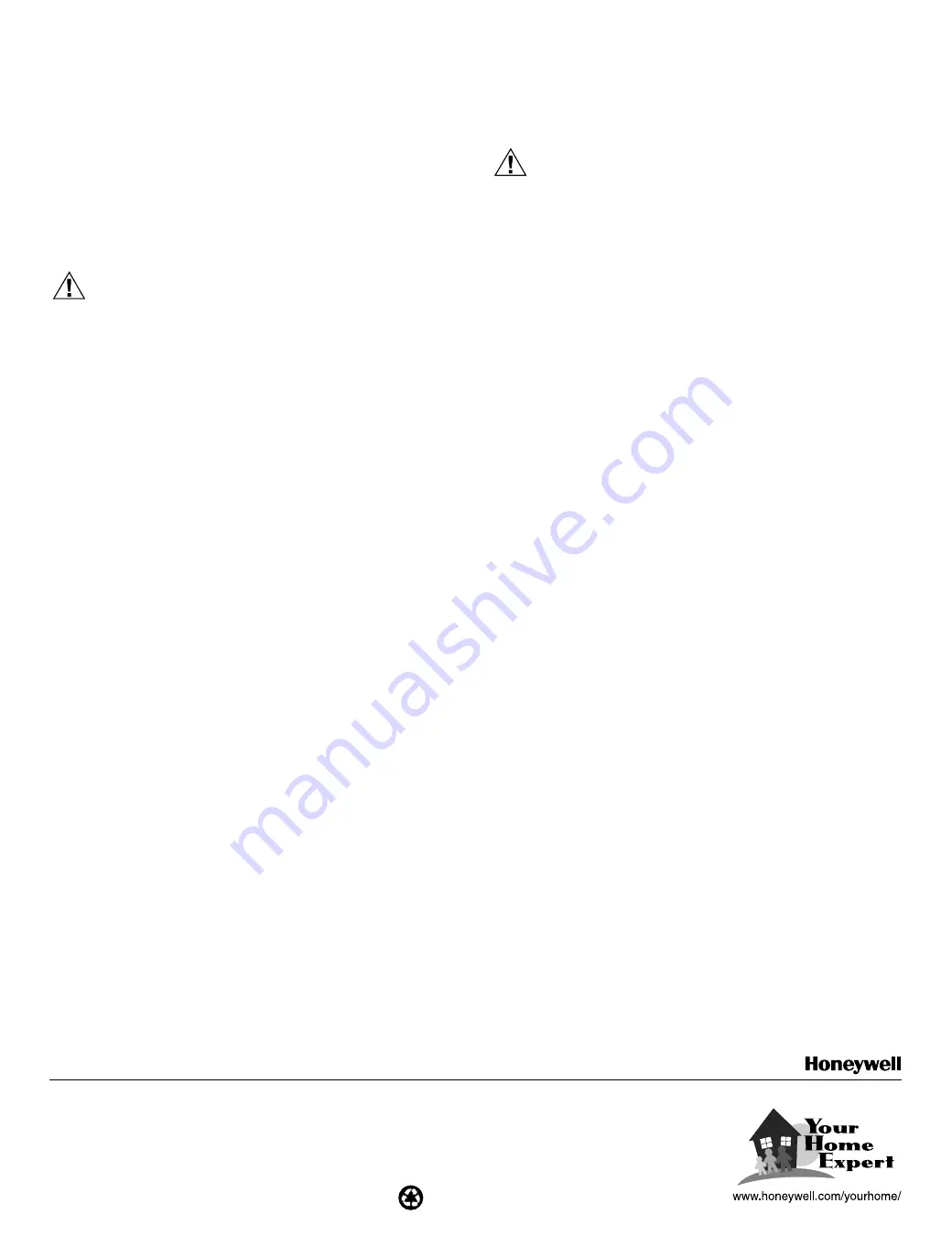
10. Seal the duct connections with duct tape.
NOTE:
To avoid sagging and stress on the humidifier, add support
when ducting is longer than 4 ft (120 cm).
11. Reinstall the humidifier pad assembly in the humidifier housing.
NOTE:
Be sure the water feed tube nozzle is not pinched or
kinked.
12. Hinge the cover in place and secure with the thumbscrew located at
the bottom of the cover.
WIRING
CAUTION
Hazardous Voltage.
Can cause personal injury or equipment damage.
•
Disconnect power supply before installing or servicing.
•
On multispeed blower applications, do not wire the high voltage
side of the transformer to the same power source that services
the furnace blower or the transformer may burn out prematurely.
All wiring must comply with applicable local codes, ordinances and
regulations.
1. Mount the transformer in a convenient location.
IMPORTANT
Install transformer on the outside of a grounded metal junction box
using only a 7/8 in. (22 mm) knockout hole. Place mounting tabs
into the knockout hole and firmly tighten the locking screw. Field
wiring connections and grounding means for the transformer and
enclosure shall be in accordance with the National Electrical Code
(NEC) and the Canadian Electrical Code (CEC).
2. Connect the wires to the 120V side of the transformer.
For humidity control wiring connections:
1. Wire the humidifier solenoid valve, current sensing relay or sail
switch, humidity control and transformer. Refer to humidity control
installation instructions for mounting and wiring information.
IMPORTANT
•
The humidifier must be energized during blower motor cycles for
proper operation.
•
Current sensing relay or sail switch is not needed with the
Automatic Humidity Control.
NOTE:
Select models of fan centers include humidifier taps so the
current sensing relay or sail switch are not needed.
PLUMBING SADDLE VALVE
Hot or cold water, either hard or softened, can be used in the humidifier.
1. Use the self-piercing saddle valve (included) to tap into the water
supply line at an appropriate location.
CAUTION
Chemical Hazard.
Can cause personal injury or equipment damage.
Do not use any line connected to an air conditioner.
IMPORTANT
•
The saddle valve is not designed to regulate water flow. The valve
is either open or closed.
•
To prevent debris from clogging the solenoid in-line filter, be sure
to install the saddle valve handle pointing toward the ceiling.
NOTE:
Lightly clean the copper tubing ends with fine sandpaper
before making any connections.
2. Use 1/4 in. O.D. copper tubing and connect the saddle valve to the
inlet side of the solenoid valve.
a.
Place the brass compression nut over the copper tubing.
NOTE:
Do not over tighten the compression nut. Moderate
tightness prevents leaking.
b.
Slide the brass ferrule over the tubing.
c.
Insert the tubing into the solenoid valve fitting and support the
valve while tightening the compression nut.
NOTE:
Slope the drain downward for correct drainage.
3. Connect a 1/2 in. drain tube to the humidifier drain fitting and run to a
suitable drain.
CHECKOUT
1. Open the saddle valve.
NOTE:
The furnace blower must be on for the humidifier to operate.
2. Set the thermostat setpoint to 10
°
F (6
°
C) above the room
temperature.
3. Set the Convertible Humidity Control to a high humidity setting, or
place the H1008A Automatic Humidity Control in the test position.
4. Observe the water running out of the drain line to be sure the
humidifier is working properly.
5. Check for leaks.
6. Reset the thermostat and Convertible Humidity Control to a
comfortable setting, or the Automatic Humidity Control to the desired
frost factor setting.
Printed in U.S.A. on recycled
paper containing at least 10%
post-consumer paper fibers.
69-1424EF G.H. 9-00
Home and Building Control
Honeywell
1985 Douglas Drive North
Golden Valley, MN 55422
Home and Building Control
Honeywell Limited-Honeywell Limitée
35 Dynamic Drive
Scarborough, Ontario
M1V 429






















